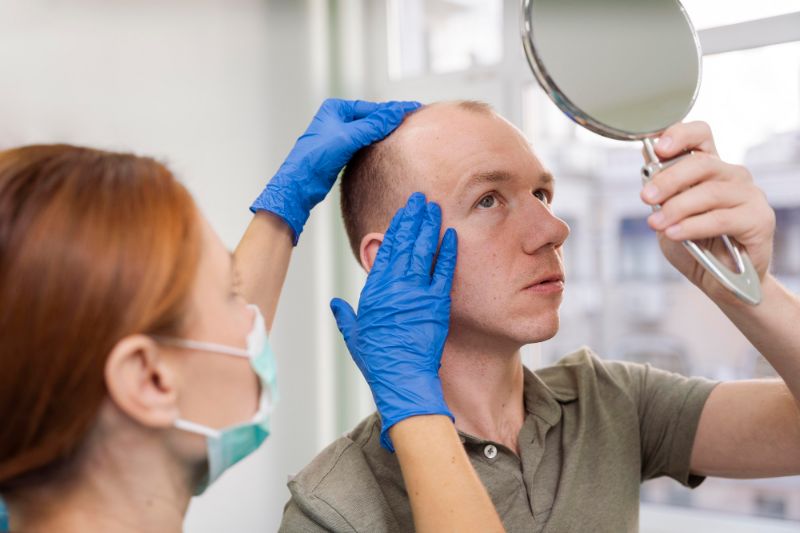Understanding the Risks of Hair Transplant Rejection: What Patients Need to Know

Hair transplantation surgery has become a popular option for people looking to restore hair growth and improve their appearance. However, like any surgical procedure, it comes with risks. One of the most significant risks associated with hair transplantation is the potential for rejection of the transplanted hair follicles.
In this article, we will discuss the risks of hair transplant rejection and what patients can do to minimize these risks.
Hair transplantation involves removing hair follicles from a donor site on the patient’s scalp and implanting them into the bald or thinning areas of the scalp. The transplanted hair follicles are expected to grow and blend in with the patient’s existing hair. However, in some cases, the body’s immune system may view the transplanted hair follicles as foreign invaders and attack them. This immune response can cause the transplanted hair follicles to die, leading to the failure of the hair transplant.
Factors That Increase the Risks of Hair Transplant Rejection
Genetic Predisposition to Autoimmune Diseases
Several factors can increase the risks of hair transplant rejection. One of the primary factors is a genetic predisposition to autoimmune diseases, which can cause the body’s immune system to attack healthy tissues, including transplanted hair follicles. Patients with a family history of autoimmune diseases should discuss their risks with their hair transplant surgeon before undergoing the procedure.
Age and Chronic Illnesses
Another factor that can increase the risks of hair transplant rejection is the patient’s age. Older patients may have weaker immune systems, which can make them more susceptible to rejection. Patients with a history of chronic illnesses or who are taking medications that suppress the immune system, such as chemotherapy, may also have a higher risk of hair transplant rejection.
Techniques That Impact the Risk of Hair Transplant Rejection
In addition to these factors, the technique used during the hair transplant procedure can also impact the risk of rejection. Two primary techniques used for hair transplantation are follicular unit transplantation (FUT) and follicular unit extraction (FUE). FUT involves removing a strip of skin from the donor site and then dissecting it into individual hair follicles, which are transplanted into the recipient site. FUE involves removing individual hair follicles from the donor site using a small punch tool and then transplanting them into the recipient site.
Follicular Unit Transplantation (FUT)
Follicular Unit Extraction (FUE)
Studies have shown that FUT carries a higher risk of hair transplant rejection than FUE. This is because FUT involves more trauma to the scalp and a larger incision, which can trigger a more significant immune response. FUE, on the other hand, is a minimally invasive procedure that causes less trauma to the scalp, resulting in a lower risk of rejection.

Minimizing the Risk of Hair Transplant Rejection
Pre-Operative Evaluation and Preparation
Patients can take several steps to reduce the risk of hair transplant rejection. Before the procedure, patients should undergo a thorough medical evaluation to identify any underlying health conditions or medications that may increase the risk of rejection. Patients with a history of autoimmune diseases may need to be closely monitored during the procedure and may require medications to suppress their immune system.
Choosing a Skilled and Experienced Hair Transplant Surgeon
During the procedure, the surgeon should take care to minimize trauma to the scalp and ensure that the transplanted hair follicles are placed in the recipient site correctly. After the procedure, patients should follow their surgeon’s post-operative instructions carefully, which may include avoiding strenuous activity, taking medications to prevent infection, and keeping the scalp clean and dry.
Following Post-Operative Instructions Carefully
In conclusion, hair transplantation surgery can be an effective way to restore hair growth and improve a patient’s appearance. However, it is not without risks, and the potential for hair transplant rejection is a significant concern. Patients can minimize their risk of rejection by undergoing a thorough medical evaluation before the procedure, choosing a skilled and experienced hair transplant surgeon, and following post-operative instructions carefully. By taking these steps, patients can increase their chances of a successful hair transplant and enjoy the benefits of a fuller head of hair.

Dr. Baykal Oymak is a highly esteemed transplant specialist hailing from Turkey, boasting an impressive 17-year tenure in the medical field. His professional journey commenced as a dermatologist at Bogazici Hospital in Istanbul, where he began to hone his expertise. Since then, Dr. Oymak has conducted a remarkable tally of approximately 14,000 triumphant hair transplant procedures within Turkey. Additionally, he holds specialization in PRP treatment and Mesotherapy, further solidifying his reputation as a versatile and accomplished practitioner in the realm of dermatology and transplantation. » SCHEDULE YOUR HAIR TRANSPLANT IN TURKEY HERE «
